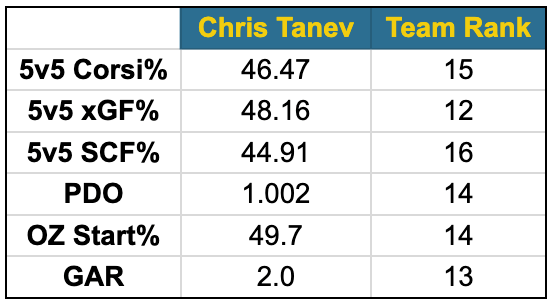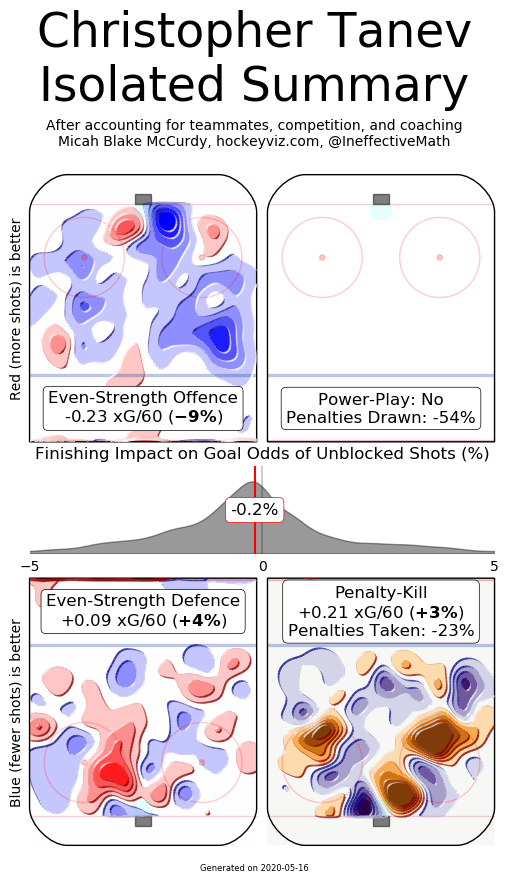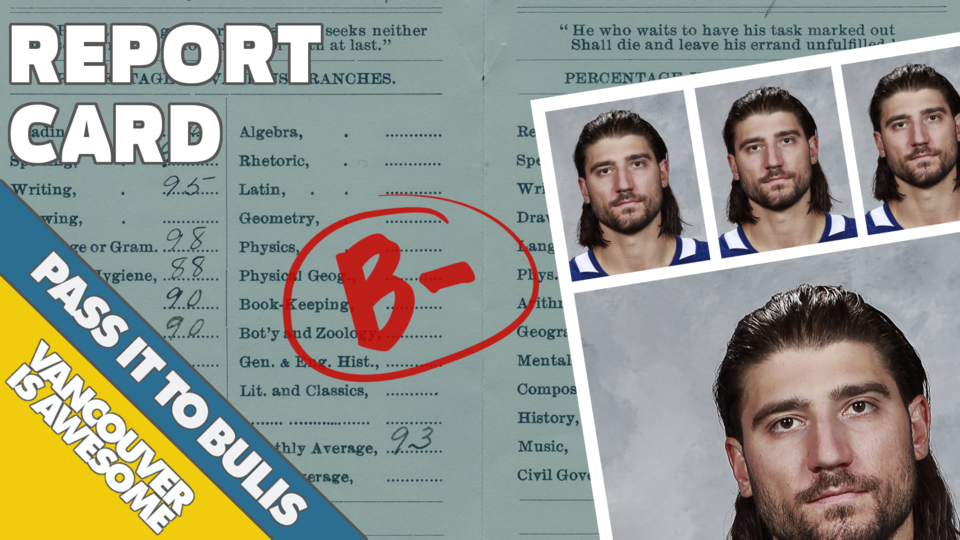When Chris Tanev first played for the Canucks, Kevin Bieksa joked, “He could have played the game with a cigarette in his mouth, he’s so calm and cool out there.”
Nine years later, Tanev is still the epitome of poise on the ice, though the older and more mature Tanev, who the team’s young players jokingly call “Dad,” might opt for a classy pipe instead of a cigarette.
There’s a possibility, however, that Tanev has played his final game as a Canuck. The veteran defenceman is an unrestricted free agent and the Canucks have a tight cap situation with some other big names to re-sign. If you ask Tanev, however, he’s not going anywhere.
“I’d love to stay with the team,” said Tanev in a Zoom call with the media. “I love the organization, I love all the guys, I love the city, the fans are great. So that’s obviously the goal, to be able to stay a Canuck as long as I can. I haven’t thought of the possibility of playing my last game [for the Canucks], to be honest.”
Tanev’s teammates definitely don’t want him to leave.
“I think I can speak for everybody on our team that Chris has been unbelievable,” said Bo Horvat. “His play speaks for itself, just the way he brings it every single night and you can always count on him. We want him to stay. Hopefully, a deal can get done where he can be a Vancouver Canuck for a long time.”
Before Tanev signs anywhere, whether back with the Canucks or somewhere else, let’s take a look back at his 2019-20 season and hand out some grades in his Report Card.
Math (Boxcar Numbers): B
It’s hard to judge a defensive defenceman solely on boxcar statistics, as they generally don’t rack up goals and assists. That said, Tanev matched his career high in points with 20 in the regular season, then added 7 points in 17 postseason games, good for second among Canucks defencemen in the playoffs.
Tanev even scored an overtime, series-winning goal against the Minnesota Wild.
The most important number for Tanev, however, was 69. No, not because that’s Bill and Ted’s favourite number, but because that’s how many games that Tanev played this season. It was also the number of games the Canucks played, making this the first time in his career he’s played every single game in a season.
Yes, sure, Tanev was injured in the final game before the season was put on hold due to a global pandemic, but it still counts.
How did Tanev avoid the plethora of injuries that struck him in previous seasons?
“I think it’s attributed to a bunch of things. Obviously, we were better than we have been in years past, we did have the puck more, we were in the offensive zone more than we had been in years past,” said Tanev. “A lot of it has to do with luck too, I mean blocking shots, the last couple years hadn’t gone my way and this year has gone well. We made some major adjustments to my equipment and my gear and things like that, and all that worked, so it was a combination of everything, I think.”
Tanev didn’t play as many minutes as past years, averaging 19:32 per game, fourth among Canucks defencemen. Where he really racked up minutes, however, was on the penalty kill, where he led all Canucks in ice time.
For those who care about plus/minus, Tanev was +4 this season, which is nice.
That goes for all of Tanev’s boxcar numbers: they were fine. So, Tanev gets a fine grade in Math: B.
Science (Fancy Stats): C-
When it comes to points and games played, this was a bounceback season for Tanev. His underlying statistics, however, took a downward swing in many ways. It’s something that needs to be carefully considered as the Canucks look to re-sign Tanev.
 Chris Tanev's 2019-20 fancy stats
Chris Tanev's 2019-20 fancy statsTanev’s possession numbers were well below average, whether we look at corsi (shot attempts), expected goals, or scoring chances. At 5-on-5, the Canucks were out-attempted, out-shot, and out-chanced with Tanev on the ice.
That’s somewhat surprising, as Tanev spent the vast majority of his 5-on-5 ice time with Quinn Hughes, who led all Canucks defencemen in each of those stats by a healthy margin. Hughes had a 52.64% corsi, 52.85% expected goals, and 51.19% scoring chance share at 5-on-5. That makes sense given how strong Hughes is in transition and how well he holds the line in the offensive zone.
When Tanev and Hughes were on the ice together, however, they basically broke even in corsi and expected goals, despite usage that slanted towards the offensive zone. There’s an argument to be made that Tanev actually had a detrimental effect on Hughes on the ice. When Hughes was away from Tanev, his 5-on-5 numbers skyrocket.
Some of that is surely usage. When Hughes was away from Tanev, he was deployed primarily with Tyler Myers. That was usually when the Canucks were down by a goal or two and pressing for a comeback and their usage was almost entirely in the offensive zone.
Could the same be true for Tanev, in reverse? When Tanev was away from Hughes, it was frequently to defend a lead. We know that score effects can play into those situations, with teams down by a goal or more pushing harder offensively and carrying the play while teams defending a lead tend to sit back.
The trouble is, when we adjust for score, Tanev’s numbers don’t get any better. They’re practically the same whether we look at raw corsi, expected goals, and scoring chances or his adjusted numbers.
That said, when Tanev was away from Hughes, he did start more of his shifts in the defensive zone, though that doesn’t entirely account for how badly the Canucks got out-shot in those situations.
Overall, Tanev’s split between defensive and offensive zone starts was basically even. His PDO, a combination of on-ice shooting and save percentages, was right around average, so he wasn’t getting particularly lucky or unlucky. His Goals Above Replacement (GAR) from Evolving Hockey suggests he was the 13th-most valuable player on the Canucks of the 26 skaters that played for the team this season and the fourth-most valuable defenceman.
The pairing of Tanev and Hughes a complicated thing to consider. Hughes praised Tanev all season long for helping him on and off the ice. They were considered a strong pairing by most and their respective strengths seemed to complement each other. But it has to be asked, is Tanev the right defence partner for Hughes going forward?
We can also look at Tanev’s isolated impact heat map from HockeyViz. For the first time in his career, Tanev’s impact in the defensive zone was in the red, allowing more dangerous chances for his opponents.
 Chris Tanev's isolated impact heat map via HockeyViz.com
Chris Tanev's isolated impact heat map via HockeyViz.comFor the longest time, these heat maps were one of the strongest analytical arguments for Tanev. As much as he didn’t have a positive impact offensively, he was still incredible defensively. This season, however, it isn’t as flattering.
Let’s be clear: the bulk of these numbers are not outright terrible. For the most part, they’re simply below average. It’s certainly troubling that his corsi this season wasn’t better given that he was playing with a puck possession beast like Hughes, but he was far from a black hole. The real concern is that he’s about to turn 31, history shows that most defencemen go on the decline after 30, and he’s about to sign a new contract.
Are these numbers a warning sign for Tanev’s future or an outlier — a blip on the chart for the otherwise analytically-sound defenceman? For now, he gets a C- in Science, with a hope that he can pull up that grade next semester.
Social Studies (Leadership and Intangibles): A+
Tanev has served as one of the Canucks’ alternate captains for four years and is a key part of their leadership group in the locker room. He’s been especially important for the team’s youth, taking it upon himself to welcome them to the Canucks in the same way Kevin Bieksa, Dan Hamhuis, and Keith Ballard once welcomed him.
“[Tanev] has been just as big off the ice for me as he has been on the ice,” said Hughes. “Anyone who knows me, I’m not a huge cook, so Chris would always bring me over for dinner. As a young kid, 19 years old, in a new city, you don’t really know anyone. Chris is the first person that brought me in. My first day I was there, Chris took me to dinner.”
For a lot of the young players, Tanev provides a support system, giving them someone to talk to or have fun with. He and Hughes even started playing chess together regularly, keeping their minds sharp.
“For a young kid, it’s so important to have someone like that,” said Hughes, “so you have a guy there you can always talk to and count on. If there’s ever a problem or if I ever needed anything, I could turn to Chris. I think he’s that guy, he’s the leader of our team.”
Language Arts (Communication): A-
Tanev has always been on the quieter side, but he really started to open up in media scrums this past season. He’s clearly grown more comfortable in his leadership role, which includes the responsibility of speaking for the team. He’s almost as relaxed and comfortable with a microphone in his face as he is on the ice.
Clearly, he’s worked on his public speaking skills.
It's a brotherhood. 🤣👏 Chris Tanev was not messing around during last night's lineup read... 😳 pic.twitter.com/QiuInkJgcR
— Vancouver #Canucks (@Canucks) August 22, 2020
Away from the rink, Tanev is still pretty quiet. He has a Twitter account that has gone unused since 2012 and his Instagram has just six posts.
Three of those posts, however, include his adorable pug Riley, including his first ever post on the ‘gram, the famous “pug in a box.”
That’s a perfect Instagram post, the platonic ideal of the internet. So, Tanev gets some bonus points there, coming around to a solid A-.
Physical Education: A+
Tanev is an elite athlete playing in the NHL.
Electives (Special Teams): B-
No one played more minutes on the Canucks penalty kill than Tanev this season. In fact, he averaged 20 seconds more per game than the next most frequent penalty killer, Alex Edler.
Tanev’s total of 235:43 on the penalty kill was second in the entire NHL behind only Esa Lindell of the Dallas Stars and nobody in the NHL blocked more shots than Tanev on the penalty kill: 48 total.
That’s all positive, but there are some troubling signs. Only Tanner Pearson and Edler were on the ice for a higher rate of unblocked shot attempts against than Tanev on the penalty kill and the same is true for expected goals against and actual goals against.
That said, it can be hard to parse out what is one player’s responsibility on the penalty kill from the penalty-killing unit as a whole. It should be noted that Tanev didn’t play much with the Canucks’ best penalty killer this season, Tyler Motte, as they were generally on different units. Tanev instead played more with Jay Beagle, Tim Schaller (before he got traded), Brandon Sutter, and Tanner Pearson. Beagle and Sutter had some struggles while shorthanded this season, while Pearson was arguably the Canucks’ worst penalty killer.
All that is to say, the penalty kill can be difficult to assess. There’s an assumption that the coaching staff knows who performs best while shorthanded and it’s hard to judge a penalty killer solely by shot statistics.
Given his past performance on the penalty kill and his willingness to continually put his body on the line, I’m leaning toward an appeal to authority here, even if it’s a logical fallacy. At the same time, I can’t entirely discount those underlying shot statistics. The Canucks coaching staff likely give him an A. I’m going to creep that down to a B-. Feel free to trust the guys coaching in the NHL over me if you like.
Overall: B-
There were so many positives surrounding Tanev’s 2019-20 season, but those underlying statistics are really hard to dismiss. What might have been a solid 3.50 GPA gets dragged down by that Science class grade.
How do the Canucks assess his 2019-20 season as they prepare to re-sign him? Tanev means a lot to the Canucks locker room and he eats up minutes on the penalty kill. He’s a key part of their leadership group and is loved by both his teammates and the fans. But what if his play is about to sharply decline?
It’s a difficult question to ask, particularly about such a well-liked player. If it were anyone other than Tanev, maybe I would have been harsher on this Report Card and he would’ve ended up worse than a B-. It’s hard for me to dismiss my own bias.




